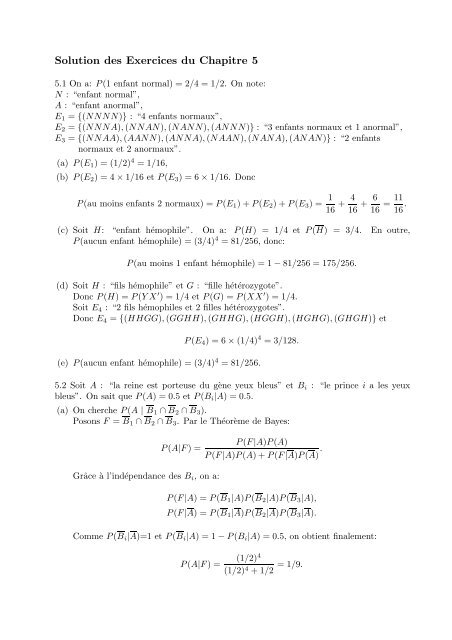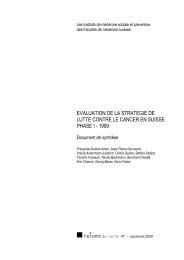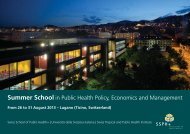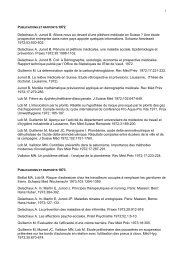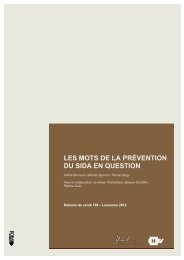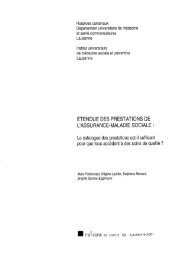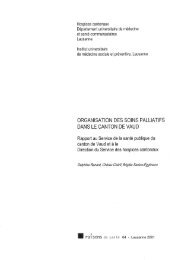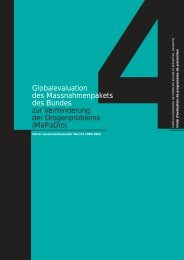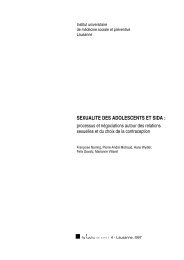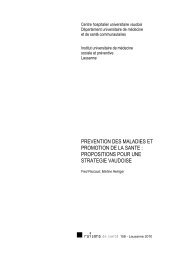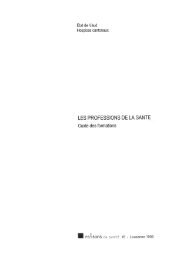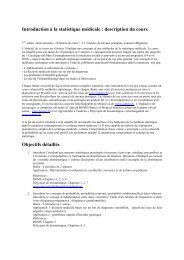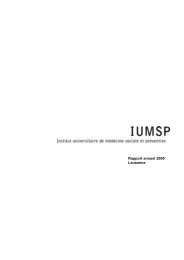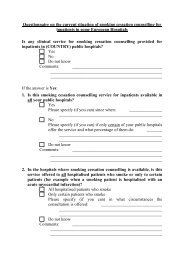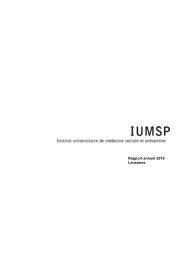Create successful ePaper yourself
Turn your PDF publications into a flip-book with our unique Google optimized e-Paper software.
Solution des <strong>Exercices</strong> du Chapitre 5<br />
5.1 On a: P (1 enfant normal) = 2/4 =1/2. On note:<br />
N : “enfant normal”,<br />
A : “enfant anormal”,<br />
E1 = {(NNNN)} : “4 enfants normaux”,<br />
E2 = {(NNNA), (NNAN), (NANN), (ANNN)} : “3 enfants normaux <strong>et</strong> 1 anormal”,<br />
E3 = {(NNAA), (AANN), (ANNA), (NAAN), (NANA), (ANAN)} :“2enfants<br />
normaux <strong>et</strong> 2 anormaux”.<br />
(a) P (E1) =(1/2) 4 =1/16,<br />
(b) P (E2) =4× 1/16 <strong>et</strong> P (E3) =6× 1/16. Donc<br />
P (au moins enfants 2 normaux) = P (E1)+P (E2)+P (E3) = 1 4 6<br />
+ +<br />
16 16 16<br />
= 11<br />
16 .<br />
(c) Soit H: “enfant hémophile”. On a: P (H) = 1/4 <strong>et</strong> P (H) = 3/4. En outre,<br />
P (aucun enfant hémophile) = (3/4) 4 =81/256, donc:<br />
P (au moins 1 enfant hémophile) = 1 − 81/256 = 175/256.<br />
(d) Soit H :“filshémophile” <strong>et</strong> G : “fille hétérozygote”.<br />
Donc P (H) =P (YX ′ )=1/4 <strong>et</strong>P (G) =P (XX ′ )=1/4.<br />
Soit E4 :“2filshémophiles <strong>et</strong> 2 filles hétérozygotes”.<br />
Donc E4 = {(HHGG), (GGHH), (GHHG), (HGGH), (HGHG), (GHGH)} <strong>et</strong><br />
P (E4) =6× (1/4) 4 =3/128.<br />
(e) P (aucun enfant hémophile) = (3/4) 4 =81/256.<br />
5.2 Soit A : “la reine est porteuse du gène yeux bleus” <strong>et</strong> Bi : “le prince i alesyeux<br />
bleus”. On sait que P (A) =0.5 <strong>et</strong>P (Bi|A) =0.5.<br />
(a) On cherche P (A | B1 ∩ B2 ∩ B3).<br />
Posons F = B1 ∩ B2 ∩ B3. ParleThéorèmedeBayes:<br />
P (A|F )=<br />
Grâce à l’indépendance des Bi, ona:<br />
P (F |A)P (A)<br />
P (F |A)P (A)+P (F |A)P (A) .<br />
P (F |A) =P (B1|A)P (B2|A)P (B3|A),<br />
P (F |A) =P (B1|A)P (B2|A)P (B3|A).<br />
Comme P (Bi|A)=1 <strong>et</strong> P (Bi|A) =1− P (Bi|A) =0.5, on obtient finalement:<br />
P (A|F )=<br />
(1/2) 4<br />
(1/2) 4 +1/2 =1/9.


